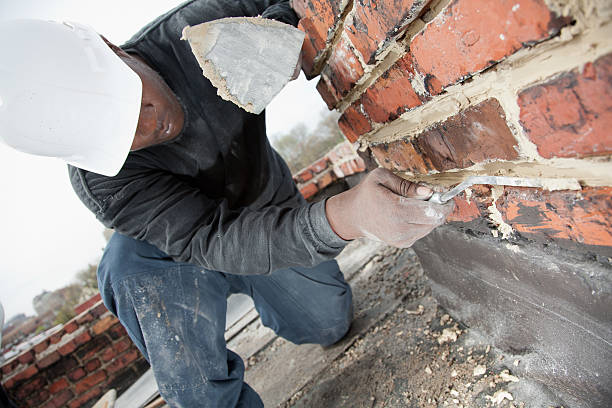Unlocking the Keys of Sustainable Masonry Building Practices for Eco-Friendly Buildings
In the realm of contemporary building, the quest of sustainable methods has actually come to be critical. Amongst the myriad approaches to eco-friendly structure, sustainable stonework building stands apart as a reliable and long lasting method that holds a riches of untapped capacity. From the choice of materials to innovative building methods, the keys to achieving sustainability within stonework building are multifaceted and appealing. By discovering the advantages, products, strategies, and future fads of sustainable stonework, a much deeper understanding of just how these methods can form the future of eco-friendly structures arises.
Benefits of Sustainable Masonry Building And Construction
Accepting lasting stonework building methods not just decreases environmental effect however likewise provides long-lasting financial benefits to builders and communities. By using products like recycled blocks, obstructs, and rocks, builders can significantly lower the carbon impact of their tasks while advertising source effectiveness. Furthermore, lasting masonry building and construction strategies, such as correct insulation and thermal mass buildings, can enhance power performance within buildings, resulting in decreased operational expenses with time.
Additionally, the durability and resilience of masonry frameworks add to long-term financial benefits. Buildings built using lasting stonework techniques frequently call for less repair and maintenance, equating to set you back savings for contractors and homeowner. The durability of masonry materials additionally guarantees that structures continue to be stable and protected, lowering the need for frequent renovations or replacements.
Eco-Friendly Stonework Products
Utilizing environment-friendly stonework products is a pivotal action in the direction of boosting the sustainability of construction methods and minimizing ecological effect while making best use of lasting economic advantages. Lasting stonework products are sourced, generated, and used in a way that minimizes total ecological effect. Sustainable concrete obstructs incorporate recycled accumulations and might include improved insulation properties, contributing to energy performance in buildings.
Additionally, all-natural materials like adobe, rammed planet, and straw bundles provide outstanding thermal mass residential properties, decreasing the need for home heating and cooling power. These products are typically in your area readily available, promoting local economies and decreasing transportation-related carbon discharges. By picking environment-friendly stonework materials, building projects can dramatically minimize their ecological impact and contribute to the creation of much healthier, a lot more lasting developed environments.
Energy-Efficient Stonework Methods
Power performance plays an important duty in boosting the sustainability of masonry building methods. By implementing energy-efficient stonework methods, building contractors can considerably lower the overall energy consumption of a building, leading to reduced functional costs and a smaller ecological impact. One key energy-efficient masonry technique is making use of thermal mass, which involves incorporating dense products like concrete or block right into the structure's structure to take in and keep warmth. This aids control indoor temperature levels, decreasing the demand for mechanical heating and cooling systems.

Technologies in Sustainable Masonry
Current advancements in lasting masonry methods have actually brought around cutting-edge strategies that are reshaping the building and construction market. One such development is the advancement of self-healing concrete, which makes use of bacteria embedded within the concrete to recover cracks autonomously. This advancement not only minimizes upkeep expenses yet likewise improves the resilience of masonry structures, adding to their sustainability.
One more noteworthy development is making use of recycled aggregates in masonry building and construction - masonry contractor. By including materials such as crushed ceramic waste or recycled glass into concrete mixes, home builders can lower the ecological influence of building jobs while maintaining structural integrity. This method not just diverts waste from garbage dumps yet likewise saves natural deposits, making it a key innovation in lasting masonry building
In addition, the assimilation of digital design devices, such as Building Info Modeling (BIM), is transforming the method masonry frameworks are intended and constructed. BIM permits for even more accurate estimations, reduced material wastefulness, and improved power effectiveness, eventually leading to even more sustainable structure techniques. These advancements jointly indicate an encouraging future for sustainable masonry building in the period of environmentally friendly structures.
Future Trends in Masonry Sustainability
With the cutting-edge strides made in lasting stonework techniques, the future fads in masonry sustainability are poised to more revolutionize the building and construction market. One of the essential patterns forming the future of masonry sustainability is the increased integration of innovation. Improvements such as Building Info Modeling (BIM) and virtual fact simulations are being used to maximize stonework building processes, causing decreased material YOURURL.com waste and boosted energy effectiveness in buildings.
Additionally, the growth of novel lasting materials is set to play a substantial role in enhancing the eco-friendliness of stonework building and construction. masonry contractor. Advancements like self-healing concrete, recycled aggregates, and bio-based binders are gaining grip for their ability to lessen ecological impact while maintaining structural honesty

Conclusion
Finally, sustainable masonry building techniques provide countless advantages for green buildings. By using environment-friendly materials and energy-efficient strategies, masonry can add to a more sustainable built environment. Developments in sustainable stonework are continually being created to even more enhance the environmental performance of structures. Looking in the direction of the future, the trend of masonry sustainability is expected to expand, resulting in even more eco-friendly and energy-efficient construction techniques in the years ahead.